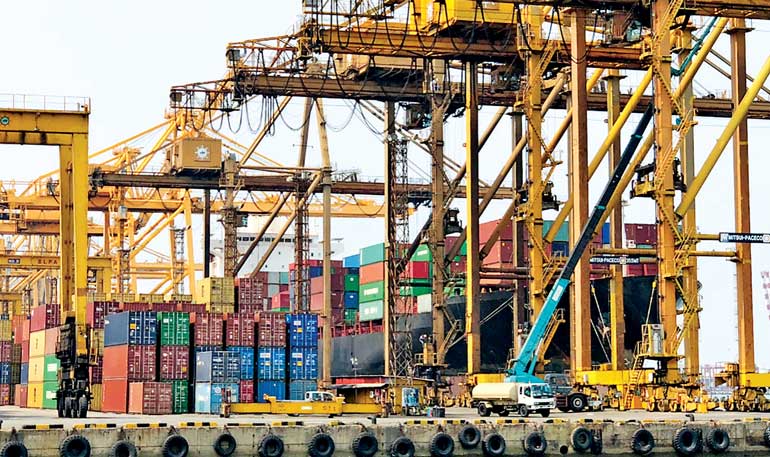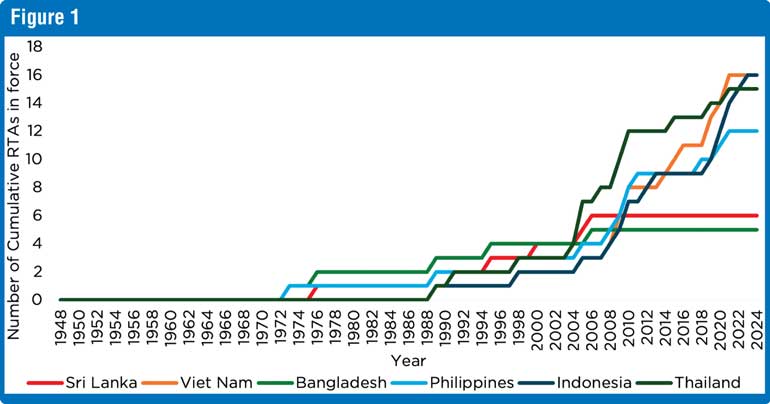Sunday Dec 14, 2025
Sunday Dec 14, 2025
Friday, 30 May 2025 03:00 - - {{hitsCtrl.values.hits}}


 A recent Policy Note published by the Centre for a Smart Future (CSF) outlined right (8) priority trade and competitiveness reforms for Sri Lanka, in responding to global economic challenges. In a previous article – the first in our three-part series published in this newspaper (16 May), we recapped the key messages from Priority Areas 1 and 2 contained in the Policy Note – ‘Doubling down on tariff and para-tariff liberalisation’ and ‘Designing credible trade adjustment support’. In this second article we cover Priority Areas 4, 5, and 6 – ‘Deepening and widening trade partnerships’, Enhancing trade negotiation capacity and private-public consultation’, and ‘Rethinking strategic international engagement’.
A recent Policy Note published by the Centre for a Smart Future (CSF) outlined right (8) priority trade and competitiveness reforms for Sri Lanka, in responding to global economic challenges. In a previous article – the first in our three-part series published in this newspaper (16 May), we recapped the key messages from Priority Areas 1 and 2 contained in the Policy Note – ‘Doubling down on tariff and para-tariff liberalisation’ and ‘Designing credible trade adjustment support’. In this second article we cover Priority Areas 4, 5, and 6 – ‘Deepening and widening trade partnerships’, Enhancing trade negotiation capacity and private-public consultation’, and ‘Rethinking strategic international engagement’.
Priority Area 4: Deepening and widening trade partnerships
Though Sri Lanka is unique in being the only country to have bilateral free trade agreements (FTAs) with both India and Pakistan (entered into in 2000 and 2005, respectively), it has since been slow at pursuing bilateral and multilateral trade integration. Only in recent years have two new agreements, with Singapore and Thailand, been signed. Even then, there appears to be a regression – while the Singapore and Thailand FTAs were comprehensive ones (going beyond goods, to investment and services), more recent attempts seem to be to forge simple goods agreements (for instance, the Indonesia-Sri Lanka Preferential Trade Agreement).
In sharp contrast, Viet Nam and Thailand have accelerated forward with their trade integration – both bilaterally, as well as through mega-regional agreements like RCEP and CPTPP (See Figure 1). Sri Lanka’s trade partnerships lack both width (number of partners), and depth (level of integration). For comparison, Viet Nam’s 16 trade agreements cover more than 60 countries accounting for almost 90 percent of global GDP.
Contemporary trade agreements are deeper and more complex than Sri Lanka’s existing bilateral agreements with India, Pakistan, Singapore and Thailand. The focus now should be on agreements like RCEP and CPTPP that pin Sri Lanka down to undertaking deeper and more modern trade and investment reforms.
Meanwhile, a priority must surely be the conclusion of negotiations on the Economic and Technology Cooperation Agreement (ETCA) with India – the 14th round of which has been pending for over a year now. Sri Lanka would need to insist on asymmetric treatment as a fundamental principle of the agreement and seek an ‘early harvest’ programme that includes the increase of the garments quota from the current 8 million pieces. If the ETCA will not include an investment chapter (according to India’s new policy approach), then we must swiftly update our Bilateral Investment Treaty.
Priority Area 5: Enhancing trade negotiation capacity and private-public consultation
For the ambitious trade integration agenda set out above, Sri Lanka desperately needs to increase its capacity for handling complex and comprehensive trade negotiations. It wouldn’t be an exaggeration to say that Sri Lanka’s trade negotiation capacities are currently in dire straits. There is no longer a fully-fledged negotiation team in place, and no chief negotiator. In fact, Sri Lanka has never had a firmly established, institutionalised mechanism for trade negotiation teams.
The teams are usually brought together from different institutions to work together for the duration of a specific trade agreement and then are disbanded. Some of them are brought together again for the next one, but some are not. So, there is little institutional memory that is built up and preserved over time. Efforts to establish an Agency for International Trade (in 2017-18) fell through. More recent efforts to establish the Office for International Trade (first under its own Act but later subsumed under the omnibus ‘Economic Transformation Act’) are  uncertain. Due to the latter, the Department of Commerce was also placed in a state of unease and uncertainty. Having a permanent entity with a clear and specific mandate of pursuing trade agreements, with robust institutional mechanisms, is essential. Cobbling together officials and independent experts on an ad hoc basis can no longer be the norm.
uncertain. Due to the latter, the Department of Commerce was also placed in a state of unease and uncertainty. Having a permanent entity with a clear and specific mandate of pursuing trade agreements, with robust institutional mechanisms, is essential. Cobbling together officials and independent experts on an ad hoc basis can no longer be the norm.
In contrast to Sri Lanka’s situation, the country we most recently concluded an FTA with – Thailand – has a fully-fledged ‘Department of Trade Negotiations’.
What this also helps with is more robust and transparent private-public consultation. We see many instances where industry input into trade negotiations can be ad hoc, unpredictable, and poorly managed. This creates uneven influence for some parts of the private sector over others, it creates risks around elite capture, it fosters distrust around the consultative process and hurts negotiators’ ability to seek actionable and credible insights (on both offensive and defensive interests).
Overall, a more permanent and robust entity to handle trade negotiations, coupled with an institutionalised process for private-public consultation, is critical for Sri Lanka to advance its trade relationships in the short- and medium-term. It can help minimise Sri Lanka’s chronic adhockery in trade policy formulation, facilitate grounded identification of defensive and offensive interests, and build enthusiasm and confidence around trade integration among domestic stakeholders.
Priority Area 6: Rethinking strategic international engagement
The US tariff increase and subsequent responses by other countries and regions are disrupting the established world trade order. Countries are leveraging various regional and intergovernmental platforms when formulating their responses and finding alignment and unity. For instance, the ASEAN members issued a joint statement on the US tariff increase, calling for the WTO to anchor dialogue on how to navigate the shocks. Sri Lanka risks being isolated, as we do not have an active bloc of influence to rely on during crises like this. Sri Lanka’s efforts have focused on forums such as SAARC, IORA and BIMSTEC, but these are ill-equipped to support countries amidst the current threats. SAARC – the only regional cooperation bloc Sri Lanka is part of – is unable to provide the platform leadership that smaller economies like ours desperately need.
 As countries intensify efforts to form new blocs of shared interest (for instance, China’s attempts to woo Australia, and the potential trilateral agreement between China, Korea, and Japan) Sri Lanka too must strategically leverage any opportunities instead of ad hoc partnerships. The Ministry of Foreign Affairs must spear head such an effort with a medium- and long-term vision. This strategising also includes the decisions on whether to use or not use WTO mechanisms, as seen recently by the different approaches other countries have taken.
As countries intensify efforts to form new blocs of shared interest (for instance, China’s attempts to woo Australia, and the potential trilateral agreement between China, Korea, and Japan) Sri Lanka too must strategically leverage any opportunities instead of ad hoc partnerships. The Ministry of Foreign Affairs must spear head such an effort with a medium- and long-term vision. This strategising also includes the decisions on whether to use or not use WTO mechanisms, as seen recently by the different approaches other countries have taken.
In the next article in the series, we will explore Priority Area 7: ‘Advancing Commercial Diplomacy’.
Prioritising growth-oriented reforms
Many of the reforms and strategic initiatives discussed in this series and in the Policy Note are ripe for refocusing and prioritising today for Sri Lanka to build resilience amidst global trade tensions, and boost entrepreneurship and trade-led growth. At the outset, we note that a) many of these are not new, were initiated in the past but remain an unfinished agenda, b) the present government must recognise the purpose and objectives with which they were crafted, identify their use today, and adapt them as necessary to suit the present context; and c) ensure focused and holistic implementation, with appropriate sequencing, and with meaningful and inclusive private-public consultation.
(Anushka Wijesinha is Co-founder/Director and Senith Abeyanayake is a Research Associate at Centre for a Smart Future (CSF). CSF is an interdisciplinary public policy think tank, with researchers and advisors based in Sri Lanka and around the world. The Policy Note on which this article is based – ‘Responding to Global Economic Challenges: Eight Priority Trade and Competitiveness Reforms for Sri Lanka’ (April 2025) – is available at www.csf-asia.org/knowledge-insights. For references used in this article, read the original Policy Note.)